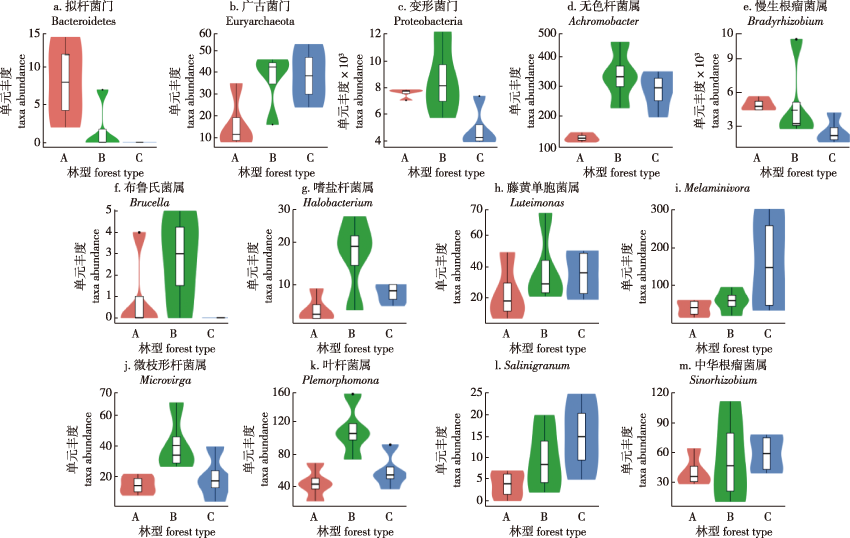 PDF(3055 KB)
PDF(3055 KB)


Community structure and diversity of soil nirK-type denitrifying microorganisms in three forest types of primitive Pinus koraiensis mixed forest in Liangshui National Nature Reserve, Lesser Khingan Mountains
CHEN Xiubo, DUAN Wenbiao, CHEN Lixin, ZHU Dequan, ZHAO Chenchen, LIU Dongxu
Journal of Nanjing Forestry University (Natural Sciences Edition) ›› 2021, Vol. 45 ›› Issue (2) : 77-86.
 PDF(3055 KB)
PDF(3055 KB)
 PDF(3055 KB)
PDF(3055 KB)
Community structure and diversity of soil nirK-type denitrifying microorganisms in three forest types of primitive Pinus koraiensis mixed forest in Liangshui National Nature Reserve, Lesser Khingan Mountains
 ,
,
 ,
,
【Objective】The community structure and diversity characteristics of soil nirK-type denitrifying microorganisms in three types of primitive Pinus koraiensis forest (Picea asperata-Abies fabri-Pinus koraiensis forest, Tilia spp.-P. koraiensis forest, and Betula costata-P. koraiensis forest) were analyzed, and the key soil physicochemical factors affecting the soil nirK-type denitrifying microbial community were explored in the Liangshui National Nature Reserve of the Lesser Khingan Mountains.【Method】Soil samples of the selected three types of primitive P. koraiensis forest were collected in the Liangshui National Nature Reserve of the Lesser Khingan Mountains of Yichun City, Heilongjiang Province. Additionally, total soil microbial DNA was extracted, and variable range fragments of the nirK gene, which encodes the coding gene of nitrate reductase (a key enzyme in the denitrifying process), were amplified with PCR. The community composition and diversity characteristics of soil nirK-type denitrifying microorganisms in the different forest types of P. koraiensis were analyzed by using high-throughput sequencing and bioinformatic analysis.【Result】A total of 761 912 high-quality sequences of the 848 312 effective sequences of the nirK gene were obtained with high-throughput sequencing of 12 soil samples in the three types of primitive P. koraiensis forest, and the average length of these sequences was 320 bp. Soil nirK-type denitrifying microorganisms of the three forest types belong to bacteria and archaea.In addition there were a large number of sequences without clear classification information. The soil nirK denitrifying microorganisms identified in the three forest types belonged primarily to Proteobacteria at the Phylum level. However, the core genera included Bradyrhizobium, Rhodopseudomonas, Azospirillum and Burkholderia. Alpha diversity analysis showed that there was no significant difference in the four alpha diversity indices (Shannon, Chao1, Ace and Simpson index) of soil nirK-type denitrifying microorganisms among the three forest types. Beta diversity analysis showed that there were significant differences in the composition of soil nirK microbial communities among the three forest types (R=0.25, P=0.016). Metastats analysis showed that the significant differences in soil nirK microbial communities among the three forest types were with regards to Proteobacteria, Euryarchaeota and Bacteroidetes. Soil ammonium nitrogen and total nitrogen were the main soil physicochemical factors influencing soil nirK-type denitrifying microorganisms communities in the three forest types (P<0.05).【Conclusion】There was no significant difference in the alpha diversity index of the three primitive P. koraiensis forests (Shannon index, Simpson index, Ace index and Chao1 index), although beta diversity analysis showed that there were significant differences in the composition of the soil nirK microbial community among the three types of primitive P. koraiensis forest (R=0.25, P=0.016). Ammonium nitrogen and total nitrogen were the main soil physicochemical factors that significantly affected the soil nirK denitrifying microorganism in the three forest types.

Lesser Khingan Mountains / primitive Pinus koraiensis forest / nirK gene / denitrifying microorganisms / community structure / high-throughput sequencing / Liangshui National Nature Reserve
| [1] |
王宁, 杨雪, 李世兰, 等. 不同海拔红松混交林土壤微生物量碳、氮的生长季动态[J]. 林业科学, 2016,52(1):150-158.
|
| [2] |
孙雪, 隋心, 韩冬雪, 等. 原始红松林退化演替后土壤微生物功能多样性的变化[J]. 环境科学研究, 2017,30(6):911-919.
|
| [3] |
|
| [4] |
|
| [5] |
|
| [6] |
|
| [7] |
|
| [8] |
|
| [9] |
|
| [10] |
朱杰, 刘海, 吴邦魁, 等. 稻虾共作对稻田土壤nirK反硝化微生物群落结构和多样性的影响[J]. 中国生态农业学报, 2018,26(9):1324-1332.
|
| [11] |
|
| [12] |
|
| [13] |
|
| [14] |
|
| [15] |
|
| [16] |
|
| [17] |
鲍士旦. 土壤农化分析[M]. 北京: 中国农业出版社, 2000.
|
| [18] |
张维玲, 张金池. 不同种植时间脐橙园土壤理化特性研究[J]. 南京林业大学学报(自然科学版), 2018,42(4):181-186.
|
| [19] |
郝玉琢, 周磊, 吴慧, 等. 4种类型水曲柳人工林叶片-凋落物-土壤生态化学计量特征比较[J]. 南京林业大学学报(自然科学版), 2019,43(4):101-108.
|
| [20] |
王国兵, 王瑞, 徐瑾, 等. 生物炭对杨树人工林土壤微生物生物量碳、氮、磷及其化学计量特征的影响[J]. 南京林业大学学报(自然科学版), 2019,43(2):1-6.
|
| [21] |
|
| [22] |
|
| [23] |
|
| [24] |
|
| [25] |
|
| [26] |
|
| [27] |
杜倩, 梁素钰, 李琳, 等. 阔叶红松林土壤酶活性及微生物群落功能多样性分析[J]. 森林工程, 2019,35(1):1-7.
|
| [28] |
罗希茜, 陈哲, 胡荣桂, 等. 长期施用氮肥对水稻土亚硝酸还原酶基因多样性的影响[J]. 环境科学, 2010,31(2):423-430.
|
| [29] |
王婷, 刘丽丽, 张克强, 等. 牛场肥水灌溉对土壤nirK、nirS型反硝化微生物群落结构的影响[J]. 生态学报, 2017,37(11):3655-3664.
|
| [30] |
|
| [31] |
|
| [32] |
|
| [33] |
|
| [34] |
|
| [35] |
|
| [36] |
|
| [37] |
|
| [38] |
|
| [39] |
姜一, 陈立新, 段文标, 等. 小兴安岭原始红松混交林林隙土壤不同形态氮含量[J]. 生态学杂志, 2014,33(12):3374-3380.
|
| [40] |
|
| [41] |
|
| [42] |
|
| [43] |
|
/
| 〈 |
|
〉 |